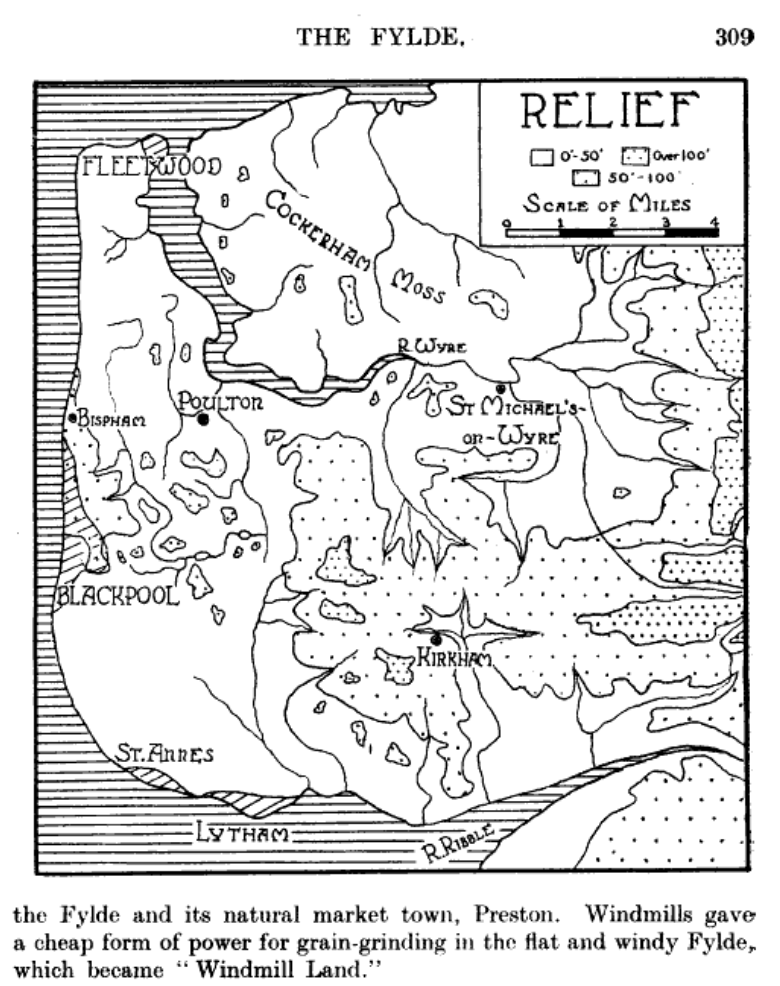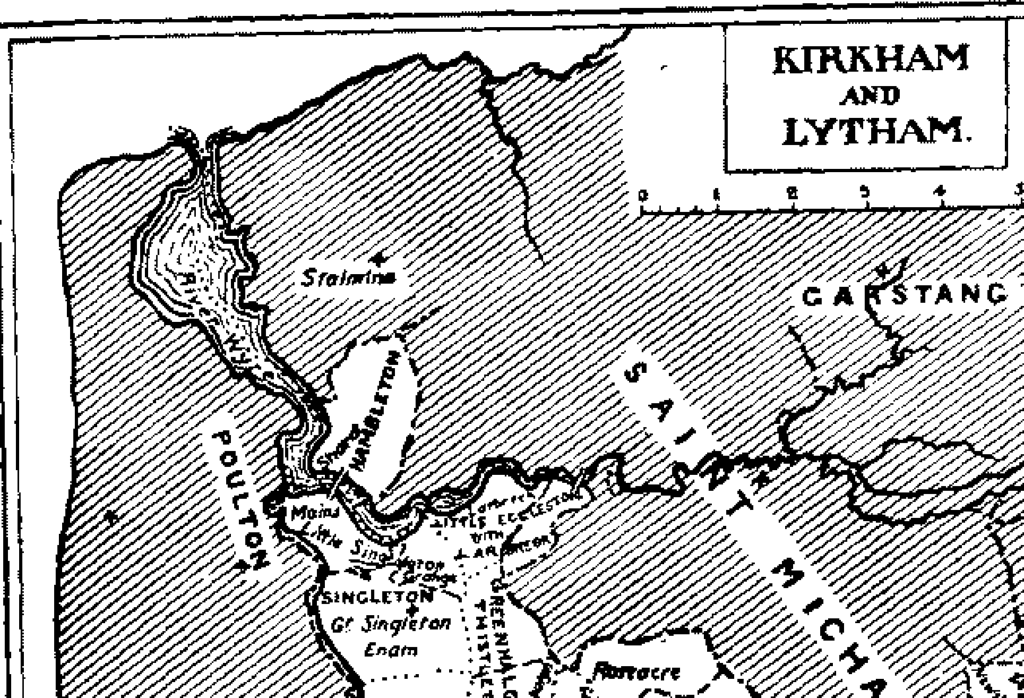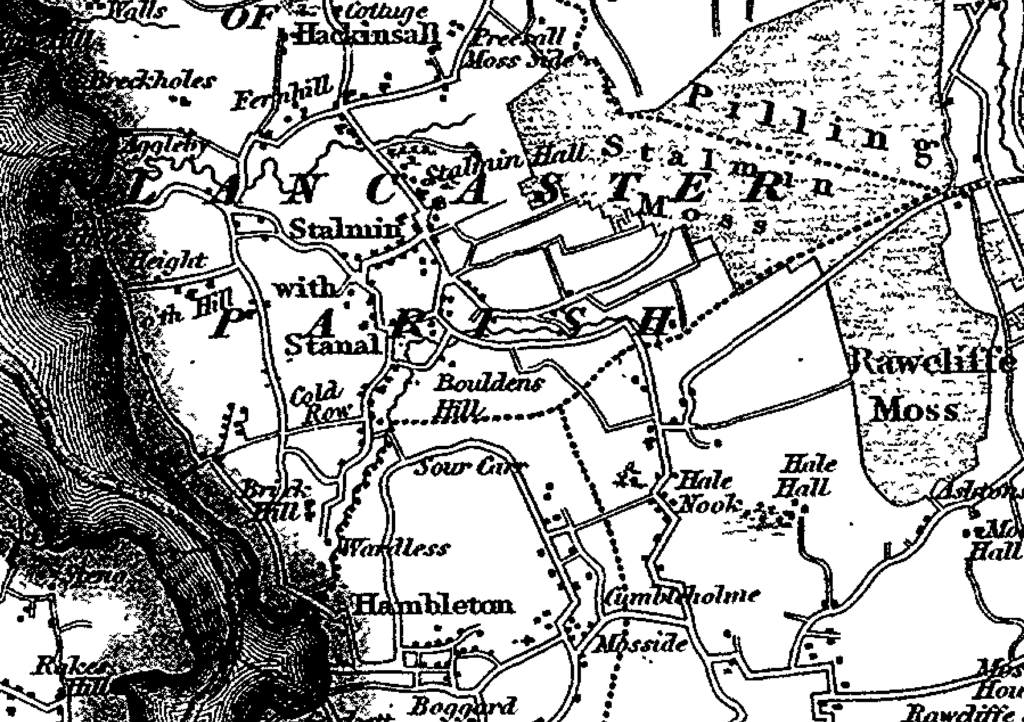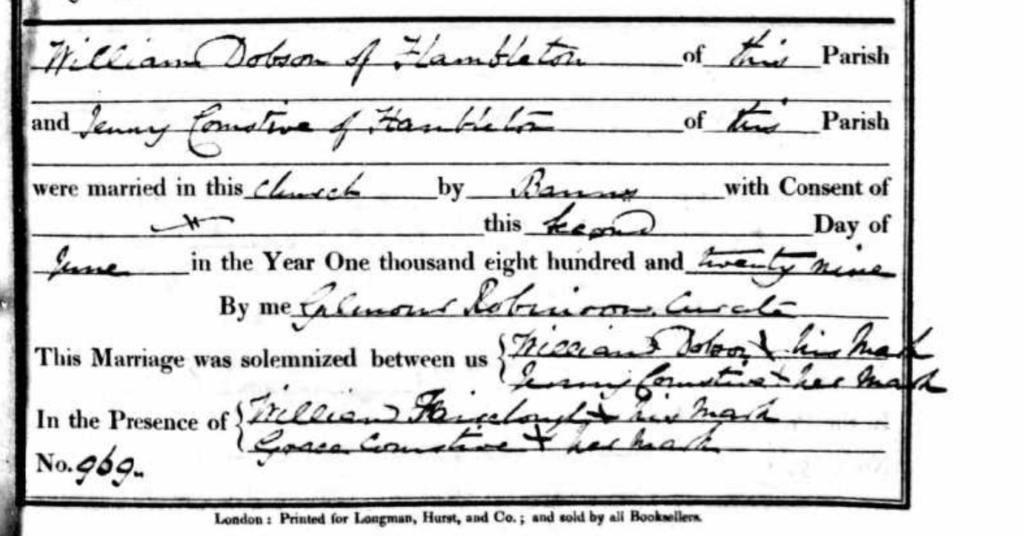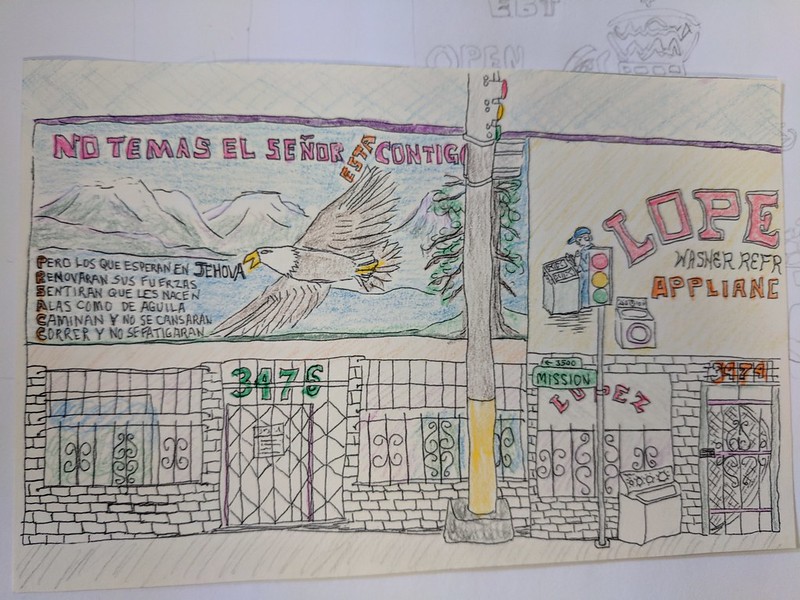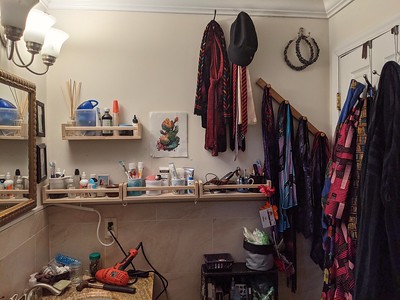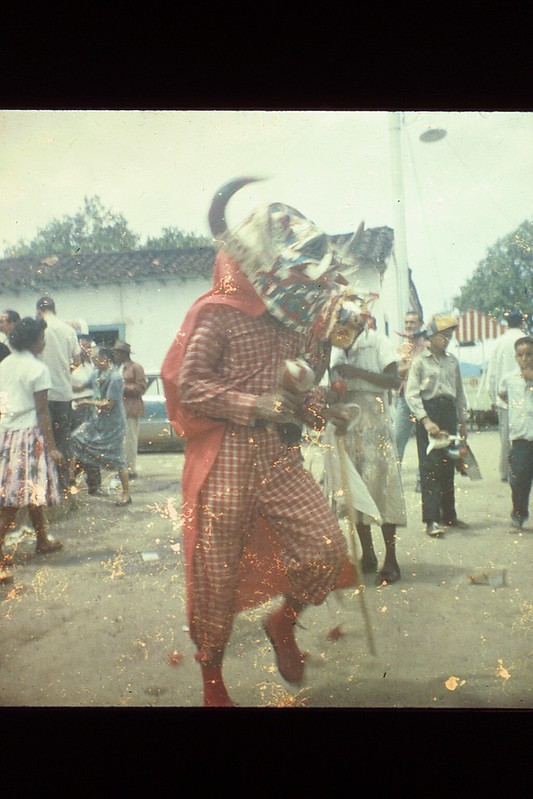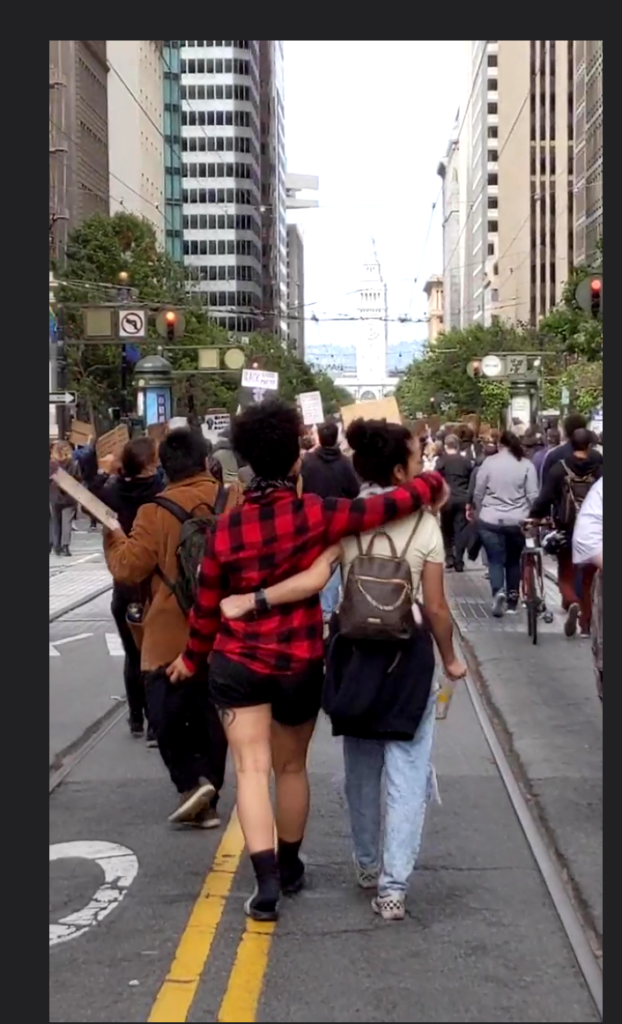In my last geneology post I wrote about Jenny Cumpsty and her daughter Jennet Dobson. Jennet married William Crane, a tailor in the town of Garstang, in 1863.
First, a quick summary of William’s life since he is central to our story.
William was born in 1841 in Pilling in a family of farmers. He was an apprentice tailor by age 17, married at age 21 in Garstang and set up his own business as a tailor there and then in Barrow-in-Furness. He and his wife Jenny had three children. After his wife died of smallpox in 1871, he lost his business as a tailor and worked in brickyards and coal mines for the rest of his life. He remarried in 1872 in Farnworth, near Bolton, and had two more children, living and working at Top o’th’ Meadows in Darcy Lever. His second wife died in 1890. He married a neighbor in 1895. He was still working as a navvy in 1911 at age 70. In 1917 William died, a widower for the 3rd time, at age 76.
The Cranes north of the Wyre
Now let’s pull back in time a bit, and look at William’s side of the family.
William’s parents were John Crane, or Craven (b. 1812) and Ellen Parker.
John Crane’s parents were John Crane (b. 1775) and Cathrine Lewtas.
Ellen Parker’s parents were William Parker and Betty Hoole. It is a bit confusing so here is a tree view:
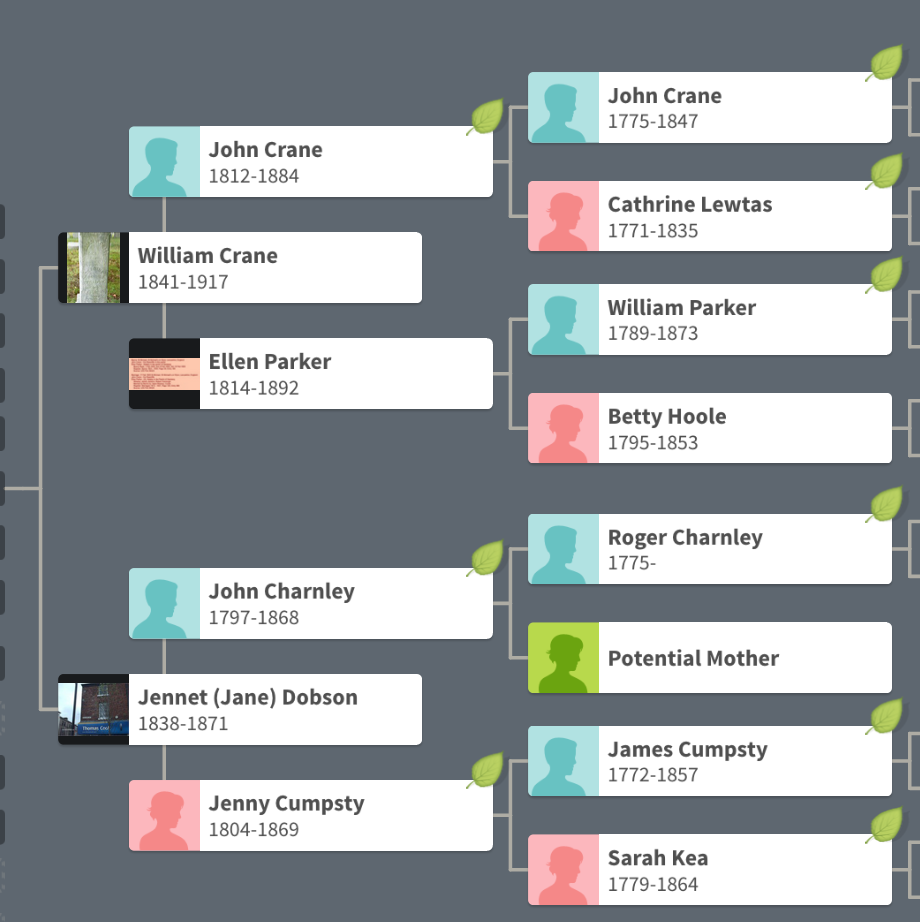
Maps
As a refresher, here are two maps of the area over the river Wyre. The Pilling Moss was part of a larger area of peat bogs north of the Wyre and south of Morecambe Bay. All the villages I mentioned in the last post are within about 5 miles of each other, in case that wasn’t clear. That also holds true for this post!
Overview of the area near Garstang

Detail from 1829 map showing Pilling, Stalmine, Hambleton, Out Rawcliffe, Kirkland, Garstang, Calder Vale
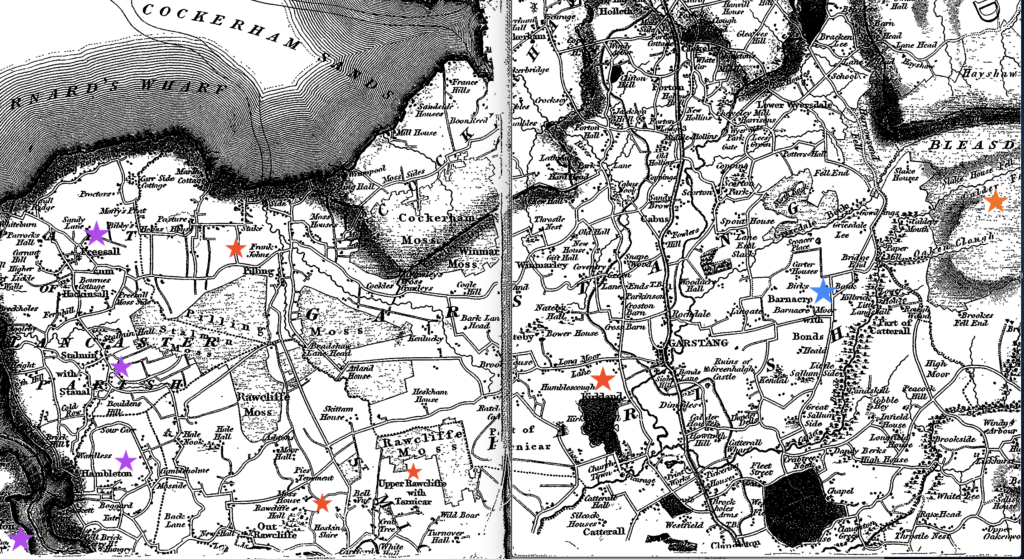
Preesall and Stalmine, 1775-1792
My 5th great-grandfather, John Craven, was a farmer in Stalmine, Out Rawcliffe, and Pilling. He was born in 1775 in Preesall, around the time of the Pilling Moss Bog Burst.
In 1792, at age 17, he married Catherine Lewtas in St. James Church, Stalmine. John and Catherine could both sign their own names, which surprised me!

The Crane family in Out Rawcliffe
Some time in the 1790s, the family moved from Stalmine to Out Rawcliffe.
Their first child, Alice, was born in 1793. Their children were Betty, b. 1794; Ann, b. 1797; Richard Lewtas, b. 1798; William, b. 1800; Robert, b. 1803; Thomas Lewtas, b. 1805; Catherine, b. 1807; Matthew, b. 1809. Their son John Crane who was my direct ancestor was born in 1812, and his younger brother Henry in 1814. So, John and Henry grew up as the youngest sons in a large family of farmers and agricultural laborers.
Here’s a summary of what happened to John’s older siblings. Alice married Thomas Bimson, a tailor in Pilling and then a licensed victualler in Liverpool; after his death, she married Thomas Higginson, a farmer of 60 acres, and lived in Bradshaw Lane, Pilling. Her oldest children took Higginson’s name, married, and lived on farms next to her in Pilling. Richard Lewtas Crane ended up as a laborer in Liverpool. William became a farmer in St. Michaels on Wyre; he could not write his name. Robert became a carter, and lived with his sister Catherine and her family for most of his life. Catherine married a local farmer, Thomas Fox; she couldn’t write her name. Thomas Lewtas Crane married and was an agricultural laborer – unlike his older brothers and sisters, he was literate, signing his name to his marriage certificate.
Their mother Catherine died at age 60, in 1835.
The Crane families move to Pilling
Back to our person of concern, John Crane, William’s dad, born in 1812.
In 1841, John Crane senior is listed in the Pilling census as John Crane, age 65, farmer, living with his children Thomas, 35; Robert, 35; Henry, 24, and two young servants.
Next door to him in Pilling is John Crane, 25, agricultural laborer, with his wife Ellen and their children Matthew, Henry, and William, 3 weeks old. That’s our John Crane & his son William Crane!
Ellen Parker’s parents were William Parker and Betty Hoole. She was born in Nateby in 1814.
Ellen’s father was an agricultural laborer; both parents were from Out Rawcliffe. William’s parents were from the same area. Betty Hoole was born in Barnacre and Upper Rawcliffe in 1795. She married William when she was 15.
John married Ellen Parker in 1835 when he was 22 and she was 20. So, when we see them in the 1841 census, they have been married for 6 years, are still under 30, and have three children. John may be working on his father’s farm alongside his brothers.
In 1847, John’s father John Crane senior died.
John Crane junior moves back to Out Rawcliffe
In 1851, John and Ellen Crane are living in Out Rawcliffe with thir children Matthew, 14, agricultural laborer; Henry, 12, ditto; William, 9, ditto; John, 8, and Richard, 6 are both in school; Robert, age 1, is the youngest. William, John, and Richard were born in Pilling, while Robert was born in Out Rawcliffe, so that gives us a likely date for the family’s move, between 1845 and 1850. It would make sense that they moved after John Crane senior died, in 1847.
In 1861, John and Ellen are still in Out Rawcliffe living with Matthew, 24; Richard, 16; Robert, 11, all agricultural laborers. Their daughter Catherine, 7, is in school.
William the Tailor
Meanwhile, William Crane became an apprentice tailor with Thomas Wilkinson in Kirkland, a village or town that looks a bit larger than Out Rawcliffe, more or less a satellite town of Garstang — certainly larger than Pilling. We see him in the 1861 Census, age 19, living in the household of Thomas and Ann Wilkinson.
Unlike his older brothers and his younger brother Robert, he isn’t stuck on the farm. It would likely have cost money to buy him a place as an apprentice.
In 1863, on Feb. 4th, William married Jennet Dobson. In 1861, Jennet was a servant for the Hesketh family in Tarnacre Lane, Upper Rawcliffe — less than a mile by the road to Kirkland. Perhaps they met in Kirkland; we can imagine that he did some tailoring for the Hesketh family, but there’s no way to know. I don’t have an image for their marriage record but would love to see it to see who was literate and who witnessed.
Caroline Crane was born in Garstang, 24 November 1863. Their son John James was born in 1866 in Kirkland, (also called Churchtown). By 1869, the family had moved north across Morecambe Bay to 74 Scott St., Barrow-in-Furness, where Jane Elizabeth was born.
By 1871, from the census, William and Jennet, Tailor and Tailoress, ages 29 and 32, were living in Barrow-in-Furness at 183 Dalton Street. Caroline, 7 and John J., 5, are in school. Jane is one year old. They have two lodgers, ages 19 and 20. I get the impression that Barrow-in-Furness, then nicknamed “The English Chicago”, was a not-too-horrible industrial and port town, with a shipyard and a railroad, happily NOT located in a giant peat bog surrounded by miles of treacherous tidal sands, so it sounds like another step up in life for the Cranes. I hope their little family was happy and that Caroline had a good early life.

Later that year, 21 August 1871, Jennet died. The family was living at 305 Dalton Street.
William the Brickmaker
First, let’s follow William after his wife’s death. He was not able to stay in Barrow-in-Furness and he lost his tailoring business. Perhaps there were crushing doctor bills. I also imagine the children were brought to live with relatives until their father found a stable situation.
In September 1872 he married Frances Ann Hardman, in Farnworth with Kearsley. William was 31. On the marriage record, he signed his own name though his wife signed with an X. His father John Crane (junior) witnessed the marriage, signing with an X, listing his occupation as a furnaceman. Frances Ann’s father was a collier, and her mother witnessed the marriage (X, her mark). William was working as a brickmaker.

William and his father John are still close physically to Pilling and Out Rawcliffe, but in time and modernity they have leapt from generations of peasantry to an urban area in the thick of the industrial revolution. Farnworth, now basically part of Bolton ie Greater Manchester, was a huge coal mining center and also the home of paper mills, iron foundries, cotton mills, and brick and tile factories. Its population more than doubled from 1851 to 1871 when it was a town of 20,000.
In 1881, William, 39, is an excavator (navvy) at 127 Ellesmere St in Farnworth. He may have worked on rail lines into the mines, dug canals, or ditched and drained the remaining peat mosses in the Farnworth area – the census doesn’t have that level of detail. He lives with his second wife Francis Ann, 33; his son John J, 15, labor in the brickworks; Jane E, 11, scholar; and Ann, 4, his daughter with Frances Ann. They have two lodgers, Thomas Fletcher, a blacksmith, and his wife Mary E. Fletcher, 29. Note those lodgers for later! And, I notice also that Jane Elizabeth is able to stay in school at the late age of 11, probably the first “scholar” over age 10 in of her ancestral tree.
Looking at this I can’t help but admire William. From a horrible tragedy, and a downward step from having a profession to doing hard physical labor in a brickworks and then a navvy around the mines and mills, he pulled his family through. He found another wife who is caring for his children, and he is able to support them. Though we don’t know anything about his personality, we can see evidence of his values and his skill in survival.
William and Frances Ann had a second child together, Henry, born in 1884. William’s father John Crane died that same year. Frances Ann died in 1890 in Bolton leaving William, at 49, once again a widower with young children.
John Crane and Ellen Parker have a marker to their memory in the Out Rawcliffe churchyard. It mentions that he was a deacon for the church for many years and it also lists Elizabeth Ellen Gardner (b. 1848 d. 1931). Maybe Elizabeth Ellen was a niece or other relative (or someone who survived her was a relative of John and Ellen, and put up the stone for them all at once.) John Crane was a farmer in Out Rawcliffe for 10 or 20 years before his children scattered and he became a furnaceman in Farnworth/Bolton.

Map of Farnworth, turn of the century
For context, here is a 1908 map of Farnworth. You can click through on it to download it & get a higher resolution for zooming in.
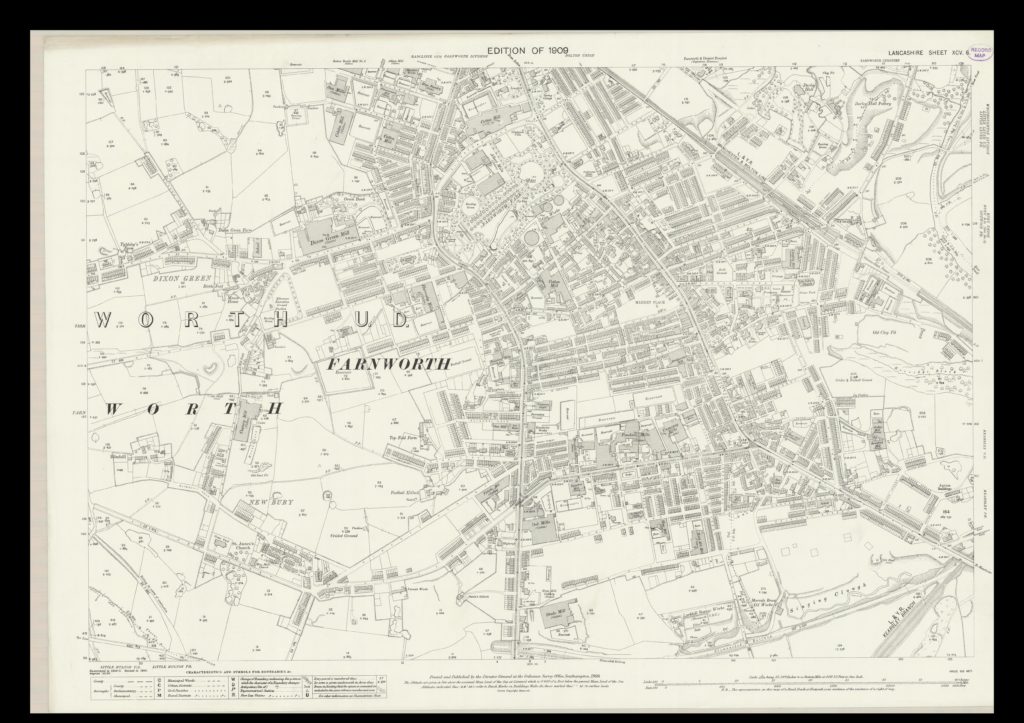
Caroline in the mills
We’ve seen William Crane move from Barrow-in-Furness to Farnworth & remarry in 1871-1872. By 1881 his younger children are with him. But where is his oldest daughter, Caroline, in 1881?
I found her in Great Lever, living with her uncle Henry Crane’s widow, Alice (Lowe) Crane. Alice, head of the household, age 38, is a charwoman. Her sons William 18; James, 16; John, 14; Richard, 12, are coal miners. Henry Junior, the baby, is 3 years old and god knows who takes care of him while everyone is at work. Alice’s brother William Lowe, 36, is an excavator, along with a lodger, John Hazler. Finally we come to 17 year old Caroline, Alice’s niece, Comber Tenter in a cotton mill.
Much respect to Alice who had to keep house for all these people while working outside the home herself. I like to keep in mind they were not likely to have running water so someone would have had to fetch water in buckets daily – and imagine doing the laundry for four coal mining teenage boys!
I found this definition of a comber tenter from the online version of A Dictionary of Occupational Terms Based on the Classification of Occupations used in the Census of Population, 1921. (ah,those females and their e-textiles!!)
comber (cotton) ; comb minder, comber tenter. Operates combing machine, which combs out short fibres in preparation of fine cotton yarns; guides cotton laps on to rollers, starts machine, receives combed cotton, in form of slivers, in boxes or cans, and removes cans as they are filled.
I ended up reading some stuff about the history of cotton mills, which first developed in Lancashire, and about the various roles in a mill. The combing/carding machine, basically a giant toothed roller, was invented in 1760.
Carding: the fibres are separated and then assembled into a loose strand (sliver or tow) at the conclusion of this stage.
The cotton comes off of the picking machine in laps, and is then taken to carding machines. The carders line up the fibres nicely to make them easier to spin. The carding machine consists mainly of one big roller with smaller ones surrounding it. All of the rollers are covered with small teeth, and as the cotton progresses further on the teeth get finer (i.e. closer together). The cotton leaves the carding machine in the form of a sliver; a large rope of fibres.[11]
In a wider sense carding can refer to the four processes of willowing, lapping, carding and drawing. In willowing the fibres are loosened. In lapping the dust is removed to create a flat sheet or lap of fibres; Carding itself is the combing of the tangled lap into a thick rope or sliver of 1/2 inch in diameter, it can then be optionally combed, is used to remove the shorter fibres, creating a stronger yarn.
A carding room in a mill would have been full of dangerous machinery and very fine airborne particles of cotton which caused breathing problems for many workers. Children – if Caroline worked in the mill from a younger age onward — would scuttle around under and inside the working machinery to pick up bits of lint and help keep everything running. I think that role is what “tenter” implies. I don’t have a good source for this photo but it shows a young girl taking a spool of combed cotton from a machine, I think maybe after it is drawn:
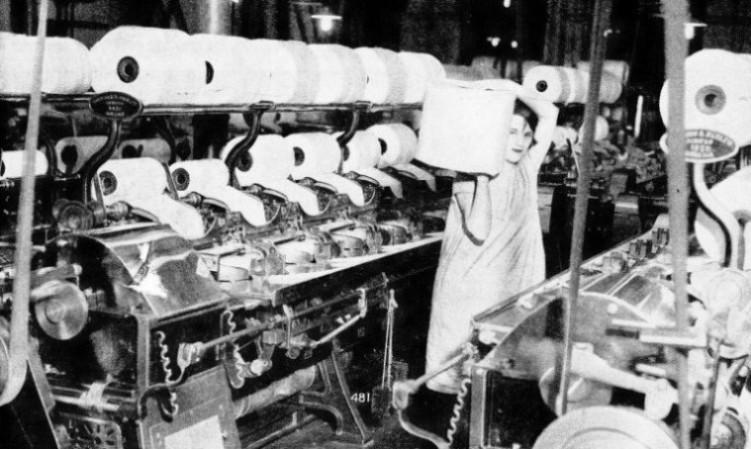
Being in the mills and mines of Lancashire in the mid 1800s meant some of the family were likely to have been in trade unions. It may be possible to find them in specific unions if I had access to those records! Rochdale (where Caroline’s future husband had roots) was an early example but by the 1850s there were huge union and mill vs. worker fights.
In Preston in 1853 mill owners locked out 20,000 workers for 36 weeks and the workers’ families began to starve. The center of industrialization was also a center for worker organizing! Perhaps Caroline Crane was able to join the Amalgamated Association of Card and Blowing Room Operatives that formed in 1886!
Caroline married Ralph Hutchinson in 1884 in Great Lever.
The Hutchinsons and Doodsons
Let’s look at Ralph Hutchinson and his ancestry. Ralph was my great-great-grandfather!
Ralph Hutchinson was born in 1866 in Kearsley. His parents were James Hutchinson and Ellen Doodson.
James Hutchinson was born in 1843 in Kearsley. His parents were Adam Hutchinson and Ann Allen, both born in Lancashire around 1800. Most of the men and boys in the family (in 1841) worked in coal mines.
Adam Hutchinson’s parents were John Hutchinson and Margaret Tonge, both born in Kearsley in the mid 1700s. My research isn’t solid enough to go further back with any certainty.
Ralph Hutchinson’s mother Ellen Doodson was born in 1842 in Kearsley. Her parents were Joseph Doodson and Mary Rawlinson.
Joseph was born in 1805 in Kearsley; Mary Rawlinson in 1801 in Rumworth. What a weirdo, not even from Kearsley!
The family may have been affected by the Preston riots of 1843, when thousands of cotton mill workers went on strike.
In 1851 Joseph was in the mines and Mary was a weaver in a cotton mill; they lived in Rayley Row with two children and a 73 year old aunt who kept the house.
In 1861, still living in Riley Row, Joseph Doodson is still in the mines at age 56, but Mary has stopped working in the mills. Their son is in the mines and they have three daughters, including 19 year old Ellen, in the cotton mills.
The American Civil War would likely have affected the family as it contributed to the Lancashire Cotton Famine from 1861-1865.
Ellen married James Hutchinson in 1864, in Farnworth with Kearsley. They were both able to sign their names. James lists his father Adam’s occupation as a carder, and Ellen’s father Joseph was a collier.

I can’t find Ellen and James in 1871! They would have been 29 and 28, with their son Ralph around 5 and son James either not quite born or in his first year. They may have lived in Little Hulton, where James was born.
In 1881, Ellen and James are 39 and 38. They have four sons, Ralph, James, Joseph, and William, all living at 75 Primrose Lane in Kearsley. James is a coal miner, as is his 15 year old son Ralph. James, 10, and Joseph, 7, are still scholars. Ellen is notably not in the mills.
Ralph and Caroline
I am now looking at maps to think about how close Ralph Hutchinson and Caroline Crane lived and how they may have met. In 1881, Ralph was in the mines at 15, living at 75 Primrose Lane in Kearsley. His family church was St. John the Evangelist, quite close by. Caroline, in the cotton mills at 17, lived a few miles away at 22 Hall St in Great Lever. I think they may have met when Caroline’s father moved to Great Lever between 1881 and 1884.
Ralph and Caroline were married in 1884 in St. Michaels church in Great Lever. They both claim to be 20 years old, though surely Ralph was certainly lying since his birth date of 1866 is well documented. And they both list their residence as Annie Street in Great Lever, so either that’s where they were going to live when married or they may have both lived on that street and been neighbors. This seems plausible to me since other couples married on the same day have separate addresses. Ralph’s father James is listed as a collier, and Caroline’s father William Crane as a tailor — though at this point he hasn’t been a tailor since 1871; he’s been a brickmaker, an excavator, and a navvy for years. I wonder if this is a sign of his pride (or his daughter’s) in his original profession. And, I’m happy to report that both Ralph and Caroline were literate.
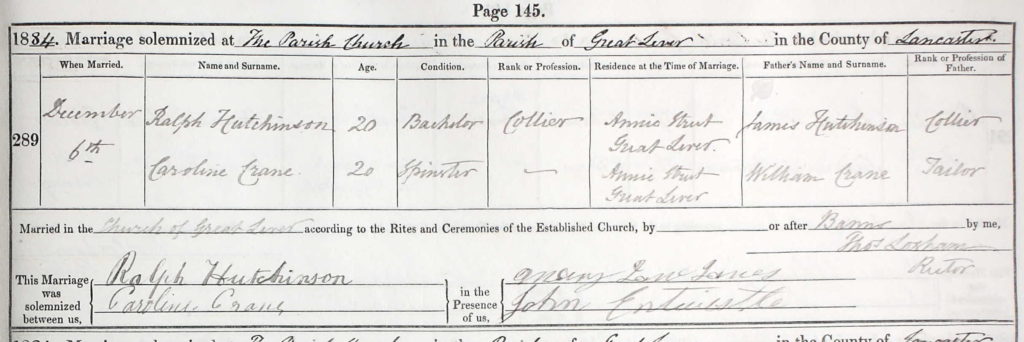
Ralph and Caroline’s life in Darcy Lever
In 1891, Caroline and Ralph lived at Top o’th’ Meadow in Darcy Lever.
In 1891, Ralph Hutchinson, 25, is a coal miner. Caroline (Crane) Hutchinson, 28, is a housekeeper (likely of her own house). Ellen, 5, is a scholar while Jennet, 3, and James, 11 months, are the youngest in the household. Caroline’s father William Crane, 49, widower and farm laborer, lives with them along with his son Henry Crane, 7, scholar, and Ann Ellen Crane, 3. Baby James is my great-grandfather.
Notably, they live next to several houses full of Fletchers, and a household of Norrises which included Martha Fletcher, age 49, sister in law of John Norris, a widow “living on her means”. It looks like Martha came to Darcy Lever to live with her married sister after she was widowed. You can guess why I mention her — William Crane (with his two young children, who need looking after) is on the prowl.
Caroline and Ralph in Farnworth
In 1901, Caroline, Ralph, and thir children are in Farnworth living at 12 Princess Street. Ralph, 35, is a chemical laborer. Ellen, 15, and Jane, 13, were both knotters (Knitters?) in a cotton mill; the initials G.O.P. or C.O.P were written over the entries – maybe an abbreviation for the name of the mill? James, my great-grandfather, is 10; Mary Ann, 8; Sarah, 6; John, 4.
As much as I make fun of growing up in the middle of Pilling Moss, growing up in the middle of the Farnworth gas and chemical works, cotton and steel mills, and coal mines may also have had its down sides, espeically as they were industrial works in the middle of yet another Moss — the whole area is a ginormous peat bog. (“Moses Gate”; Moses = Moss). The younger children seem to be at home or maybe in school, a bit longer, and more of the children grow up to be literate. The ones who aren’t blown up in a coal mine or dead of inhaling cotton fluff in the mills, that is.
Here is Princess Street on a 1908 map of Farnworth.

Ralph’s father James Hutchinson is 57 and a laborer (plasterer) in 1901. His mother Ellen is 59. William, 24, is a coal hewer. They live at 105 Brackley Street in Farnworth.
William remarries
In 1901, William, age 57, with his wife Martha (Fletcher) Crane, 59, is living in Darcy Lever, Bolton, at the same address (Top o’th’ Meadows, near Radcliffe Road and Crows Nest Road.)
He is on the same road also as James G Hardman (29) and his wife Clara, likely relatives of his late wife Frances Ann.
William is working as a carter on a farm. His son Henry, 17, is a general laborer while Ann E, 13, has no occupation listed.
James Fletcher, 24, listed as “son” is Martha’s son and William Crane’s stepson, a colliery laborer, along with their boarder William Hallows, age 50.
Next door at 407 Radcliffe Road, William’s son John J Crane, 35, a colliery engineer, lives with his wife Sarah E, 32 and their daughter Janet, 13. (Named after William’s mother, who was named after her mother and grandmother!)
About Top o’th’ Meadows
About Darcy Lever: https://www.british-history.ac.uk/vch/lancs/vol5/pp262-266
“The township abounded with coal, but it has practically been worked out. Several mines were worked till recently; one is still in operation. There is a cotton mill at the village.”
This 1860 description of Top o’th’ Meadows is online at http://www.tongefamily.info/resources/top_oth_meadows.htm
Valuable freehold estate called “BARLOWS,” or “TOP O’TH’ MEADOWS,” Situate in Darcy Lever, near Bolton. To be sold by auction by Mr. William Lomax, junr., at the house of Mr. Gillibrand, the Horse Shoe Inn, in Little Bolton, on Wednesday, the 14th day of October next, at six o’clock in the evening, subject to such conditions as will be then produced.
Lot 1. All that valuable freeshold estate called “BARLOWS” or “TOP O’TH’ MEADOWS,”, situate in Darcy Lever aforesaid, on the Highway leading from Bolton to Radcliffe, containing 14A. 3R. 30P. or thereabouts, statute measure, and comprising a good Farm House, with Two Dwelling-houses, Barns, Stables, Shippons and Gardens, adjoining or near thereto, now in the occupation of Thomas Fishwick and sub-tenants. And also FOUR COTTAGES, in the occupation of George Pickup and others, and the Mines, Minerals, and Appurtenances belonging thereto respectively. Also a ground rent of £3 a year secured on Cottages Coloured blue on the plan.
The Estate is situate within two miles from Bolton, and is connected therewith by excellent roads, and lies contiguous to the Railway from Bolton to Bury, and is half a mile from Bradley Fold Station.
There are valuable Coal Mines under and belonging to this Estate, which are let under an arrangement for a lease of ten years from 1860, at a minimum rent of £50 per annum, the Produce Rent being after the rate of £60 per foot per Cheshire acre.
I figured A is acres and R is roods, but had to look up what “P” stands for in measuring land. It is “perches” and 40 perches = 1 rood; a perch is a square rod.
Setting the scene in early 1911
In the early 1900s, Ralph’s father and mother James and Ellen died.
William Crane, Caroline’s father, wass a 69 year old widower working as a navvy laborer in Bolton, living at 551 Radcliffe Road (this is actually still Darcy Lever and I think may be either Top o’th’ Meadows or very near it.) Living with him were his son Henry Crane, 26, also a navvy; his daughter Ann Ellen Crane, 23, a charwoman; and a grandson, William Crane, age 2. They have a boarder, James Hurst, 25. James Fletcher, William’s stepson, lives two houses down on the same road.
Caroline and Ralph lived a mile or two away, at 130 Hall Lane in Farnworth. If you look on older or present day maps, Hall Lane is a main road running from Moses Gate on the north side of Farnworth, to Little Lever a mile to the east. Early in 1911, Ralph is 45, an “out of work coal miner”. Caroline is at home. Their daughter Janet, 23, is a quilt machinist in a weaving mill. James, 20, is a “side piecer for cotton spinner” in a spinning mill. Mary Ann, 18, has the occupation of “colored weaver (cotton)”. Sarah, 16, is a quilt weaver. John, 14, is a plater in the bleachworks.
Ralph and Caroline’s oldest daughter Ellen, age 25, had just married Walter Bibby, a blacksmith in December 1910. In early 1911, they are living with Walter’s widowed mother and his two younger brothers at 10 Algernon Street in Farnworth. Later, in May 1911, Ellen’s daughter Lily was born.
I’ll write more about Caroline, Ralph, and their 6 children emigrating to Rhode Island in my next post.
William Crane died in August 1917 in Bolton. His brother John Crain died in November 1917.
To sum up Caroline’s life so far:
Caroline Crane was born the oldest child of her tailor parents, in Garstang, 1863 — in the middle of the Lancashire Cotton Famine. She spent some years of her early childhood in Barrow-in-Furness north of Morecambe Bay. Her mother died of smallpox when Caroline was 7. Caroline likely went to live with her father’s brother Henry; at age 17 she was a comber in a cotton mill in Great Lever outside of Bolton. Her father had remarried and had more children — no longer a tailor, he had lost his profession and had to turn to rougher work as an excavator and navvy in the Bolton area brickworks and mines. Caroline married at age 20 to Ralph Hutchinson, a coal miner, and had 6 children with him. Her children went into the mills as teenagers, and the family lived in various locations in the Farnworth area. In 1911, at age 45 her husband lost his job as a coal miner and the family emigrated to Pawtucket, Rhode Island, in the Blackstone Valley where the U.S.’s first cotton mill was built.

